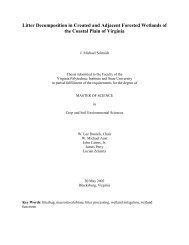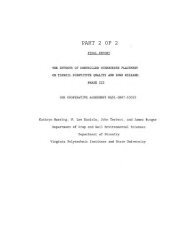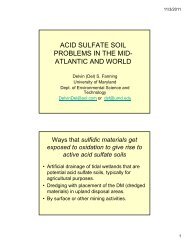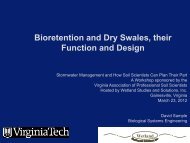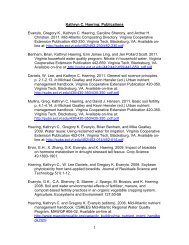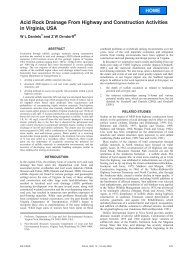Remediation of PAH-Contaminated Soils and Sediments: A ...
Remediation of PAH-Contaminated Soils and Sediments: A ...
Remediation of PAH-Contaminated Soils and Sediments: A ...
Create successful ePaper yourself
Turn your PDF publications into a flip-book with our unique Google optimized e-Paper software.
Sample Cleanup<br />
After extraction, cleanup methods are used to reduce <strong>and</strong> or eliminate sample<br />
interferences. Most soil <strong>and</strong> waste extracts require some degree <strong>of</strong> cleanup, but<br />
cleanup for water extracts may be unnecessary.<br />
For <strong>PAH</strong> analysis, the recommended cleanup methods are:<br />
� Gel permeation chromatography (3640). This is the most universal<br />
cleanup technique for a broad range <strong>of</strong> semivolatile organics. It is capable<br />
<strong>of</strong> separating high molecular-weight, high boiling material from the sample<br />
analytes. It has been used successfully for all the semivolatile base,<br />
neutral, <strong>and</strong> acid compounds associated with the EPA Priority Pollutant<br />
<strong>and</strong> the Superfund Target Compound list to clean up samples prior to<br />
GC/MS analysis for semivolatiles <strong>and</strong> pesticides.<br />
� Alumina (EPA 3610 <strong>and</strong> 3611). Method 3611 may be used for<br />
fractionation <strong>of</strong> aliphatic, aromatic, <strong>and</strong> polar analytes.<br />
� Florisil (EPA 3620)<br />
� Silica gel (EPA 3630).<br />
The decision process in selecting between the different options available<br />
generally depends on the amount <strong>of</strong> interferences/high boiling material in the<br />
sample extract <strong>and</strong> the degree <strong>of</strong> cleanup required by the determinative method.<br />
For analysis with either the 8100/8310 determinative methods, the cleanup<br />
methods 3611, 3630, <strong>and</strong> 3640 are preferred.<br />
Analysis<br />
Determination procedures include:<br />
� EPA 8100 GC Packed <strong>and</strong> capillary column with FID (flame ionization<br />
detector)<br />
� EPA 8310 HPLC Reverse Phase with UV/ Fluorescence detectors.<br />
� EPA 8270 GC MS<br />
� EPA 8275 Thermal extraction/GC MS<br />
� EPA 8410 GC, capillary column FT-IR<br />
The Mass Spec procedures are generally more specific, but less sensitive than<br />
the appropriate gas chromatographic (GC)/specific detection method. Many GC<br />
methods with either selective or non-selective detectors are more appropriate for<br />
use where the target analytes are known, are <strong>of</strong> limited number, <strong>and</strong> <strong>of</strong><br />
significantly greater concentration than potential interfering materials. When the<br />
site where samples are taken from is not well characterized, <strong>and</strong> the researchers<br />
are concerned about a large numbers <strong>of</strong> analytes, analysis by GC/MS or<br />
HPLC/MS may be more appropriate.<br />
81



